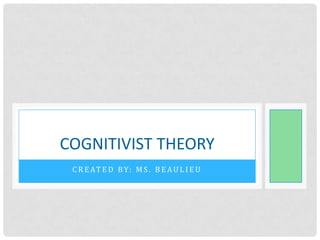
Cognitivist
- 1. COGNITIVIST THEORY C R E AT E D B Y: M S . B E A U L I E U
- 2. WHAT IS COGNITIVE THEORY? • Activities such as remembering and thinking are a considered a behavior. • Therefore, these activities can be observed and studied as a behavior and their effects on learning and education. • Cognitive domain- The variations of ways individuals process information. i.e. (Visual, Audio, Hands-on, etc…)
- 3. THE COGNITIVIST • Allan Paivio (1925- Current) • Developed the dual coding theory- information given visually and verbally enhance recall and recognition. • believes people process information in distinctively different ways. • Processing images v. Processing language. • Howard Gardner (1943- Current) • Developed the theory of multiple intelligenceverbal, mathematical, visual, kinesthetic, musical, interpersonal, intr apersonal, naturalist. • Believes that everyone may have all eleven intelligences but one or two are more dominate. • Believes the intelligences are influenced by biological predispositions, learning opportunities, and the individual’s cultural context.
- 4. THE COGNITIVIST • Robert Gagne (1916- 2002) • Based on the building block principle. • Five major categories of learning- verbal information, intellectual skills, cognitive strategies, motor skills and attitudes. • Incorporated characteristics of behavior modification theory and performance education • Believed that a variety of internal and external conditions must be present for learning to occur. • Learning results in observable behavior • Nine events of instruction.
- 5. THE COGNITIVIST • Benjamin Bloom (1913- 1999) • Focused on students learning domain • Classified learning into three domains • Cognitive- organization of ideas and thoughts • Affective- emotions, attitude, interests, attention, awareness • Psychomotor- students motor and physical abilities • Blooms Taxonomy • Levels move from simple to complex • Connected to mastered learning • Students continue to learn after they have already mastered a skill
- 6. CLASSROOM IMPLICATIONS • Teacher’s roles • Using Gagne’s Nine Events of Instruction teachers improved their students internal process of learning. • Using Gagne’s building block techniques the students are able to use technology in a variety of ways: beginning with something simple, such as searching the web for information to more demanding tasks like creating a website. • With the knowledge of Garner’s different intelligences teachers are able to incorporate a variety of activities that uses a variation of learning styles. • Bloom’s Taxonomy allows teachers to actively challenge students with a variety of questions ranging from recall to analysis.
- 7. CLASSROOM IMPLICATIONS • Student’s roles • Students can learn about the different intelligences they poses using Gardner’s different intelligences. • Once the students discover what intelligence(s) is(are) their strongest they can achieve higher academic goals by learning with those styles. • The students can challenge themselves by using different style questions as described by Benjamin Bloom. • Using the idea of dual coding, proposed by Allan Paivio, the students are able to analyze images and language separately to create intricate and creative answers.
- 8. PERSONAL TEACHING • Cognitive thinking involves a large amount of student and teacher participation. • I think this theory would work well in my classroom because of the different academic challenges in poses. • A wide variety of studies, techniques, and organization styles are available pertaining to the cognitive theory. • Integrating technology into the lessons would be fairly easy with the different skill levels assisted. • For example: I could teach the students a lesson and build on the ideas demonstrated in the lessons. Once the students have reached the point of mastery learning I will implement a more difficult lesson with the use of equipment.
- 9. CREDITS: • Sadker, David, Zittleman, Karen R., Teachers, Schools, and Society A Brief Introduction to Education, Ney York, NY. McGraw Hill. 2012. Print • Shelly, Gary B. , Gunter, Glenda A. , Gunter, Randolph E. Teachers Discovering Computers Integrating Technology In a Connected World. Boston, MD. Course Technology. 2012. Print. • The Thinker, Flicker (Creative Commons), Freddie Boy • Gagne’s Nine Events of Instruction, Wikispaces (Creative Commons), James Pearce and Meredith Perkins • Blooms Taxonomy, Flicker (creative Commons), Nistd6h • Apple, Microsoft Word, clip art.
